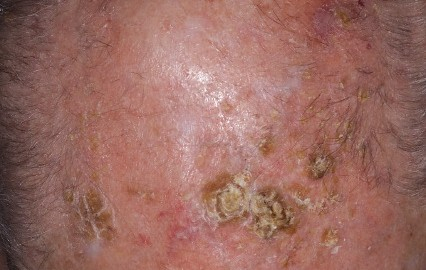Actinic keratosis is the most common precancerous skin disease in the white population and is caused by exposure to ultraviolet radiation. Prevalence — 37.5% among people 50 and older. Without therapy, actinic keratosis can develop into squamous cell carcinoma.
However, there are no clear clinical characteristics that distinguish which actinic keratosis lesions are at risk and what proportion of actinic keratosis lesions will develop into carcinoma.
The relapse rate after treatment is high which often results in a repeat need for therapy, although studies show that the effect of fluorouracil (also called 5-fluorouracil) on reducing actinic keratosis can last for years.
Single lesions can be treated with cryotherapy. However, patients with actinic keratosis often present with multiple lesions in one continuous area.
In the article estet-portal.com you can get acquainted in detail with study of the effectiveness of the treatment of actinic keratosis with available methods.
Actinic keratosis: what are the main therapies
Two network meta-analyses have been published previously. One meta-analysis by Vegter and Tolley found that aminolevulinic acid photodynamic therapy (ALA-PDT) using BF-200 ALA gel resulted in the highest reduction in lesions (75.8%) compared to 0.5% fluorouracil ( 59.9%), 5% imiquimod (56.3%) and methyl aminolevulinate photodynamic therapy (MAL-PDT) (54.8%) with a follow-up of 3 to 12 months.
Skin problems due to sun exposure
Another meta-analysis by Gupta and Paquet found that 5% fluorouracil was the most effective treatment. However, in the 2015 European Dermatology Forum guidelines, most experts did not indicate a preference for any of the most commonly prescribed treatments.
They agreed that imiquimod 3.75%, ALA-PDT, MAL-PDT, ingenol mebenate (0.015% or 0.050%), and fluorouracil 0.5% were equally effective in patients with multiple actinic keratosis lesions.
However, there was less agreement on the efficacy of 5% fluorouracil.
Actinic Keratosis: A 4-Period Efficacy Study
The authors investigated the efficacy of four commonly used treatments for actinic keratosis. Patients with five or more actinic keratosis lesions on the head, occupying one continuous area of 25 to 100 cm2, were included in the treatment program at four Dutch hospitals.

Patients were randomly assigned to treatment using:
• 5% fluorouracil cream,
• 5% imiquimod cream,
• photodynamic therapy with methyl aminolevulinate,
• 0.015% ingenol mebutate gel.
The primary outcome was the proportion of patients with a 75% or greater reduction in actinic keratosis lesions from baseline up to 12 months after the end of treatment.
Follow us on Telegram
Why should therapy for actinic keratosis include fluorouracil
A total of 624 patients were enrolled from November 2014 to March 2017. After 12 months, the reduction in the number of actinic keratosis lesions from baseline among patients treated with fluorouracil was 74.7%, among those treated with imiquimod — 53.9%, MAL-PDT — 37.7 and ingenol mebenate — 28.9%.
Compared to fluorouracil, the hazard ratio for treatment failure was 2.03 with imiquimod, 2.73 with MAL-PDT, and 3.33 with ingenol mebenate (P<0.001 for all comparisons).
No unexpected toxic effects were found.
Thus, 12 months after the end of treatment in patients with multiple lesions of actinic keratosis on the head, 5% fluorouracil cream was the most effective of the four treatments presented.
Thank you for staying with estet-portal.com. Read other interesting articles in the "Dermatology" section. You may be interested in Dangers of the active sun: why actinic keratosis occurs







Add a comment